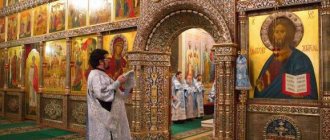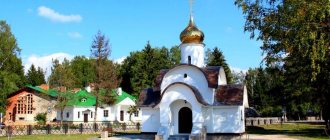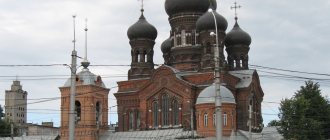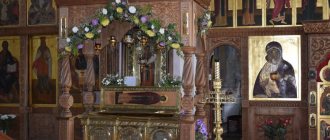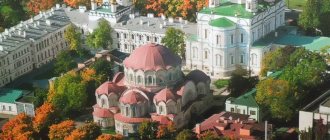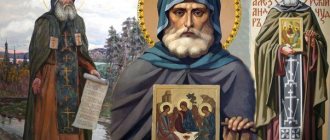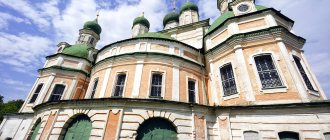Do you know where the center of Europe is? It turns out that it is located next door - in Belarusian Polotsk. The center, of course, is geographical, but why isn’t this a reason to “stroll to Europe”: it’s not so burdensome for the wallet, but a real pleasure for the eyes and soul. After all, Polotsk is a beautiful ancient city, the oldest in Belarus. There is a lot to see there: the Spaso-Ephrosyne Monastery, founded in the 12th century, is worth it. Moreover, there you can worship Euphrosyne of Polotsk herself - the famous educator, the first woman in Rus' to be canonized.
God-loving princess
The Monk Euphrosyne, who founded the Polotsk monastery, came from an ancient princely family that originated from the baptist of Rus', Equal-to-the-Apostles Prince Vladimir and his pious wife Rogneda. In holy baptism she was named Predslava. Having learned to read and write at an early age, the young princess, avoiding the games and amusements typical of all children, spent time reading the Holy Scriptures and conversations with her spiritual mentor - the rector of the parish church, who often visited her father's house.
Such zeal aroused the respect of loved ones, but no one could foresee that young Predslava would choose for herself the difficult and thorny path of monasticism, giving it preference over all the temptations of worldly life. And that’s exactly what happened.
Beginning of monastic service
When the girl turned twelve years old, which at that time was considered adulthood, many very enviable grooms began to woo her as an eminent, rich and beautiful bride. But they all received a decisive refusal. In response to her father’s threat to force her into marriage, the girl secretly fled from home and took monastic vows in one of the nearby monasteries, receiving a new name - Euphrosyne.
The life of the saint tells us that she spent the beginning of her monastic journey in labor, copying ancient tomes kept in the library of the Polotsk St. Sophia Cathedral. Printing had not yet been invented, and the Holy Scriptures, patericons and other spiritual literature had to be reproduced only in this way.
Ascetic sisters
One day, in a dream, an angel appeared to Euphrosyne, proclaiming the will of God: to found a monastery not far from Polotsk, in the town of Seltso. The nun had this dream three times before she decided to tell Bishop Elijah about it. And he, in turn, said that he had seen the same dream. At this point the last doubts disappeared, and Euphrosyne went to Seltso in order to begin construction of the monastery. The upcoming difficulties did not frighten her also because next to her were her two sisters - her own Gordislava and her cousin Zvenislava, who also became nuns. Euphrosyne cut them herself, secretly and against the will of her parents, with whom, of course, one can only sympathize as a human being. But Euphrosyne herself sincerely believed that she acted for the good. In general, at one glance she could determine whether a person had a spark of God, whether he was ready for monasticism or not. The sisters were ready. They became her main assistants and like-minded people. The construction of the monastery, although it proceeded at a record pace, took place only thanks to Euphrosyne: at the height of construction, the plinth (thin brick from which all the churches of pre-Mongol Rus' were built) ran out, but as soon as Euphrosyne prayed, the finished brick was discovered in the oven.
Order of the Messenger of God
But soon the Lord called her to a different path. A heavenly angel was sent to Euphrosyne, who showed her the place where the Polotsk monastery would subsequently be founded. From that time on, the saint settled near the Church of the Savior in a place called Selts, two miles from the city. Along with her, another blueberry came there, whose name history has not preserved. This happened in 1125.
Filled with humility, the nun Euphrosyne wanted to serve God in solitude, secluded from the whole world, but the Lord did not want such a bright lamp of faith to remain hidden. Very soon, other maidens, fascinated by Christ, began to gather and settle around her.
Married? Never!
She was born not Euphrosyne at all, but Predslava - in the family of the Vitebsk prince Svyatoslav Vseslavich, either in 1100 or in 1104: due to the passage of years, the exact date of her birth is unknown. But something else is known. When Predslava was 12 years old, she fled from the prince’s mansion to her own aunt, the abbess of the Polotsk monastery, in order to take monastic vows. The fact is that her father planned to give her away in marriage, but Predslava did not like the candidacy of her betrothed at all. We, of course, do not know who her father appointed as her wife, but given the widespread practice of dynastic marriages at that time, we can assume that Svyatoslav looked at the groom’s good looks and piety as the last thing. He had to think about how to strengthen his principality, and in his son-in-law he was looking for a comrade-in-arms and ally, and not a warm friend for his daughter. In a word, the young princess did not like him. But the main thing is that she basically did not want to get married. Being a smart and well-educated girl for her time, she quickly realized that she would be mortally bored in the role of a prince’s wife, that her life would flash by without leaving a trace. She was attracted by books, by the possibility of further development and education, which at that time could only be obtained within the walls of the monastery.
Construction of the temple and creation of a new monastery
Over time, the community created in this way, from which the Polotsk Monastery was subsequently formed, became quite numerous. In this regard, the reverend abbess wished to erect a new stone church on the site of the wooden church, which by that time had become dilapidated.
Local residents contributed to such a charitable cause. Voluntary donors were also found in Polotsk itself. Through their efforts, the necessary funds were collected. A local architect named John took charge of all the work. Through the prayers of Mother Superior Euphrosyne, the Lord sent down His grace on the builders of the new temple, and within seven months the walls, crowned with domes, rose to the sky, and the best craftsmen painted them with marvelous frescoes.
Over time, the Polotsk convent grew, became stronger and, after the name of the temple erected in it, began to be called the Spasskaya Convent. In 1155, the venerable abbess founded another monastery nearby, this time for men, first building the Church of the Blessed Virgin Mary. These two monasteries became true centers of enlightenment in the Polotsk region. They opened schools, libraries and scriptoriums - workshops for copying handwritten books.
Book scribe
So she went to her aunt. She, however, did not dare to go against the will of Svyatoslav, who was upset by the flight of his beloved daughter: the prince had high hopes for the beautiful and clever Predslava. Everything was decided by the intercession of Bishop Elijah, who was impressed by the determination of the 12-year-old princess, who came to the monastery without spare clothes, but with a chest of books and manuscripts: only these treasures were taken by Predslava from her father’s house. Elijah protected her from the prince, and he reluctantly blessed his daughter for tonsure. The young nun took the name Euphrosyne, which means “joy” in Greek, and began to live at the St. Sophia Cathedral, imitating the Most Holy Theotokos, who lived at the Jerusalem Temple in her childhood. Here she studied books from the monastery’s library collection and copied them, which was quite a difficult task. A scribe in the 12th century was required not only to be literate, but also to have outstanding artistic abilities. After all, capital letters and headings had to be decorated with ornaments - animal or plant. It was also physically difficult work; it was not for nothing that only men had previously done it: the scribe wrote not on the table, but on the palm of his left hand, with which he rested his elbow on his knee. Just imagine: all day long, a little girl, essentially a girl, sat hunched over and wrote page after page. But at the same time she was absolutely happy.
Death in the Holy Land
In 1173, foreseeing her imminent death, the Monk Euphrosyne wished to pay her last debt to the Lord - to make a pilgrimage to the Holy Land and venerate the places associated with his earthly life. Together with her sister Eupraxia and brother David, she left Polotsk in January and, after four months of grueling walking, reached Jerusalem, where she was honored to bow to the Holy Sepulcher. And then the Venerable Euphrosyne was nearly seventy years old.
The difficult journey to the Holy Land was not in vain for the old woman. Soon she fell ill, lay down, and on May 23 she gave up her soul to the Lord, whom she served all her life. Abbess Euphrosyne, who founded the Polotsk monastery in her homeland, in Jerusalem, in the monastery of St. Theodosius the Great, was buried. Fourteen years later, her incorruptible relics were transported and placed in the Kiev Pechersk Lavra as the greatest shrine.
Subsequent life of the monastery
After the repose of the holy abbess, the monasteries founded by her continued to develop and prosper, but ahead of them lay the difficult trials that befell the Russian land in the 16th and 18th centuries. The men's monastery was destroyed and has not survived to this day, but the Polotsk Spaso-Euphrosinievsky Monastery, having survived years of decline and poverty, managed to be revived in the 19th century.
In 1833, work began on a major overhaul of the Spassky Church, which had become very dilapidated by that time and had been neglected in recent years. Other monastery buildings were also repaired, and a little to the side, on the banks of the Polota River, a new sister cell building was erected.
In the second half of the 19th century, two more churches appeared on the territory of the monastery - in honor of St. Euphrosyne of Polotsk and the Cathedral of the Exaltation of the Cross. At the same time, the monastery of Euphrosyne of Polotsk was ranked among the first-class monasteries, and a women’s theological school began operating under it, which reached its heyday at the beginning of the 20th century.
Shortly before the October Revolution, the relics of the founder of the monastery were solemnly transferred from the caves of the Kiev Pechersk Lavra to Polotsk. So, after seven hundred years, Saint Euphrosyne returned to her brainchild. The Polotsk monastery greeted her with the solemn ringing of the bells of all its churches.
Years of hard times and today
During the reign of the atheistic authorities, the monastery shared the fate of most of the holy monasteries of our country. It was closed several times, valuables were removed from it, including the holy relics of its founder, and the premises were used for economic needs. But it is not for nothing that Scripture says that he who endures to the end will be saved. The Polotsk Monastery was also revived.
At the beginning of perestroika, it was returned to the believers and soon, restored to its proper form through the efforts of numerous parishioners, it regained its life. Today the nuns of the monastery are seventy sisters. Morning and evening services are held daily in the temple. They take place in the Holy Cross, Euphrosyne and Transfiguration churches.
The liturgical schedule of the Polotsk Monastery differs from the schedule that is established in ordinary parish churches. On weekdays, morning services begin at 5:45, Divine Liturgy is celebrated at 7:15, and evening services at 16:45. On Sundays and holidays, a late liturgy is added, celebrated at 9:30.
Study, study and study
Today Euphrosyne of Polotsk is equally revered in both the Catholic and Orthodox churches. And therefore, among her current fans, who come to Polotsk in many thousands, you can meet representatives of both faiths. What brings them to the Spaso-Ephrosyne Monastery? Of course, deep respect for the first Russian saint, whose relics are now kept in a silver shrine specially made for this purpose. But not only. The fame of the extraordinary effectiveness of Euphrosyne’s prayers spread throughout the Christian world during her lifetime. More than 850 years have passed since then, but the number of admirers of the Russian saint is only growing. Because it still gives hope, faith, healing, and also helps to fulfill your cherished desires. In the Spaso-Preobrazhensky Cathedral of the monastery there is a wooden shrine, in which the relics of Euphrosyne were previously kept, and now lie her seven-kilogram chains, acquired relatively recently. This crayfish is made so that you can crawl under it. It is possible and necessary if you want what you pray for to come true. You will have to crawl, taking off your shoes, on the cold marble floor. But this is a small price to pay for “making your dreams come true.” Proof of this is a book that swells day by day with thanks to Saint Euphrosyne and stories of miraculous salvation, healing and discovery. The saint sensitively responds to requests for health, for additions to the family, but still most willingly helps those who study. Therefore, the pilgrims are always full of schoolchildren with their parents, students, associate professors, and professors. in what, in what, and in her studies, the former princess, who exchanged the tower for the monastery, is always ready to help all those who suffer. If only the latter had the desire and zeal...
Magazine: Stages of the Oracle No. 3, March 2022 Category: Place of Power Author: Vera Nadezhda
Tags: prince, Orthodoxy, Steps of the Oracle, woman, faith, monastery, monastery, Polotsk, Svyatoslav Vseslavich
- Back
- Forward
